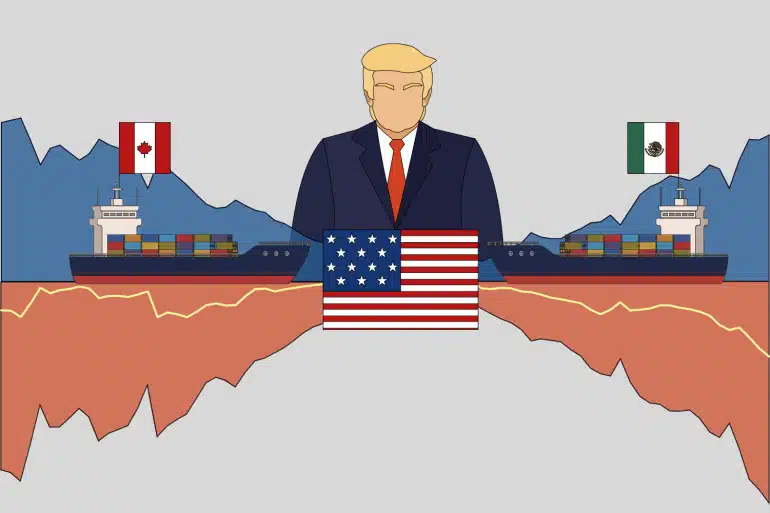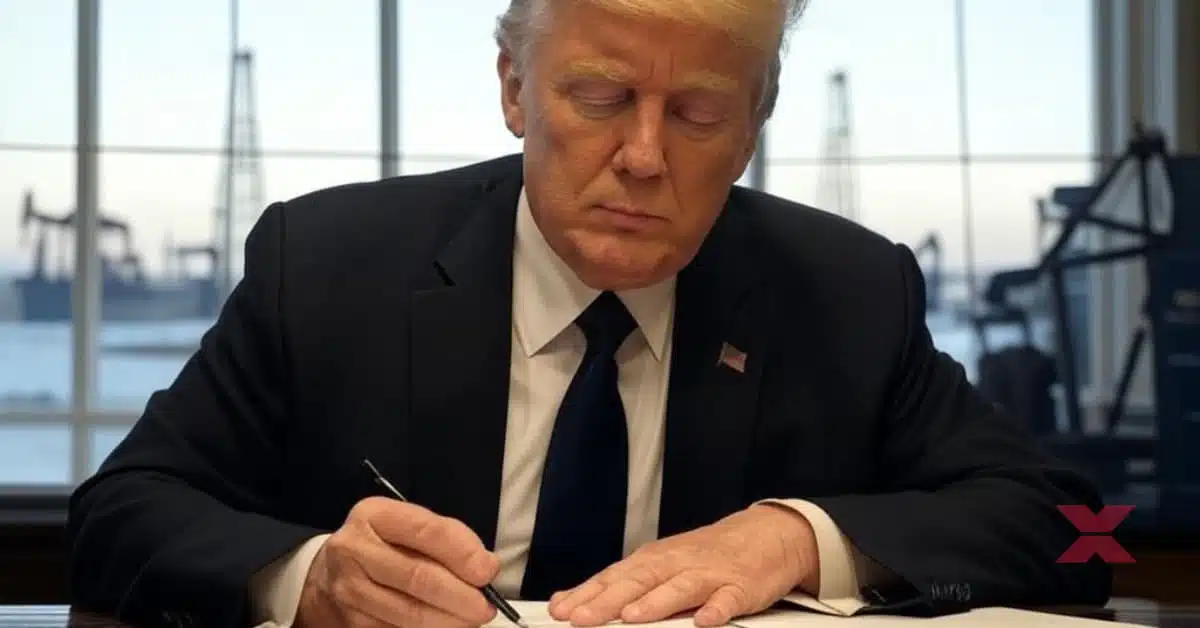The Economic Impact of President Trump’s Tariffs on Mexico and Canada: An Analytical Overview
Table of Contents
In early 2025, President Donald Trump escalated trade tensions by imposing a 25% tariff on imported vehicles and auto parts, targeting major trading partners, including Mexico and Canada. This move aimed to bolster domestic manufacturing and address trade imbalances but has sparked widespread debate regarding its economic ramifications. Given that Mexico and Canada are among the United States’ largest trading partners, understanding the impact of these tariffs on their economies is crucial.
II. Overview of Trump’s Tariff Policy
The 25% tariff on imported vehicles and auto parts, announced on March 27, 2025, represents a significant escalation in U.S. trade policy. This decision affects over $1 trillion in imports, with the expiration of temporary exemptions for Canada and Mexico in April increasing the impact to more than $1.4 trillion. The primary objective is to reduce the trade deficit and encourage domestic production by making imported goods more expensive. However, critics argue that such measures could lead to higher consumer prices and strained international relations.
III. Impact on Mexico’s Economy
A. Trade Relationship with the U.S.
Mexico’s economy is deeply intertwined with that of the United States, with a significant portion of its exports destined for the U.S. market. The automotive sector, in particular, plays a pivotal role, with numerous manufacturers operating across the border to capitalize on favorable trade agreements.
B. Affected Sectors
The automotive industry stands as the most vulnerable sector, facing potential upheaval due to increased tariffs. Additionally, the electric equipment sector is likely to experience significant disruptions.
C. Economic Projections
Economists warn of a potential “severe recession” in Mexico if the tariffs persist. A sustained 25% tariff could lead to a 12% decline in Mexican exports, resulting in a 4% contraction of the country’s GDP in 2025. The American Chamber of Commerce in Mexico has expressed concerns that these tariffs would harm both economies and fail to address the real challenges of security, migration, and drug trafficking.

IV. Impact on Canada’s Economy
A. Trade Relationship with the U.S.
Canada’s economy is highly trade-dependent, with the United States being its largest trading partner. The automotive sector is particularly significant, with substantial cross-border manufacturing and supply chains.
B. Affected Sectors
The automotive industry is poised to bear the brunt of the tariffs. Ontario Premier Doug Ford has indicated that approximately half a million jobs in the province’s automotive sector could be at risk. Additionally, the mineral processing industry may face significant challenges due to reduced export volumes.
C. Economic Projections
Canada faces the prospect of entering a recession within six months if the tariffs remain in place. The tariffs could lead to increased prices for both businesses and consumers, exacerbating existing economic pressures. The province of Quebec alone could see up to 100,000 job losses as a direct consequence of the tariffs.
V. Bilateral Trade Relations Post-Tariffs
A. Trade Flow Disruptions
The tariffs are expected to significantly disrupt trade between the United States, Mexico, and Canada, upending supply chains across North America. This disruption could lead to increased costs and delays in production, affecting various industries reliant on cross-border trade.
B. Supply Chain Reconfigurations
Companies may seek to adjust their supply chains to mitigate the impact of tariffs, potentially relocating production facilities or sourcing materials from alternative markets. Such adjustments could entail significant costs and operational challenges.
C. Future of Trade Agreements
The imposition of tariffs strains the foundations of trade agreements like the United States-Mexico-Canada Agreement (USMCA). Canadian officials have called for renegotiations to address the new trade barriers, highlighting the need for updated agreements that reflect the current economic landscape.

VI. Policy Responses and Mitigation Strategies
A. Government Actions
In response to U.S. tariffs, Canada has imposed retaliatory tariffs on U.S. goods, signaling a readiness to engage in comprehensive negotiations. Prime Minister Mark Carney emphasized the necessity for Canada to reimagine its economy to thrive under these new circumstances.
B. Business Adaptations
Companies are exploring strategies to mitigate the impact of tariffs, such as absorbing additional costs, increasing consumer prices, or relocating production facilities. For instance, automakers like General Motors and Ford are assessing their supply chains to minimize disruptions and maintain competitiveness.
VII. Conclusion
The implementation of 25% tariffs on imports from Mexico and Canada represents a significant shift in U.S. trade policy, with profound implications for the economies of all three nations. While the intended goal is to bolster domestic manufacturing, the immediate effects include strained trade relations, potential recessions in neighboring countries, and increased prices for consumers. As the situation evolves, it is imperative for policymakers and business leaders to navigate these challenges thoughtfully, striving for solutions that promote economic stability and mutual prosperity.
FAQ’s
- What prompted President Trump’s decision to impose tariffs on Mexico and Canada?
To address perceived trade imbalances, reduce illegal immigration, and encourage U.S.-based manufacturing. - Which industries in Mexico are most affected by the tariffs?
Primarily the automotive and electric equipment sectors, which rely heavily on U.S. trade. - How have the tariffs influenced consumer prices in the U.S.?
Prices of imported vehicles and auto parts have increased, impacting middle-class consumers the most. - What measures has Canada taken in response to the tariffs?
Imposed 25% retaliatory tariffs on $20 billion worth of U.S. goods and launched domestic stimulus programs. - Are there any exemptions to these tariffs?
Temporary exemptions existed but were lifted in April 2025, affecting all imports from Mexico and Canada. - What is the projected long-term impact on North American trade?
Disrupted supply chains, increased production costs, and potential renegotiation of trade agreements. - How can businesses protect themselves from tariff-related disruptions?
Diversify suppliers, explore alternative trade partners, and leverage technology to reduce overhead.





